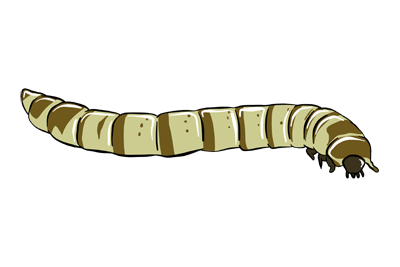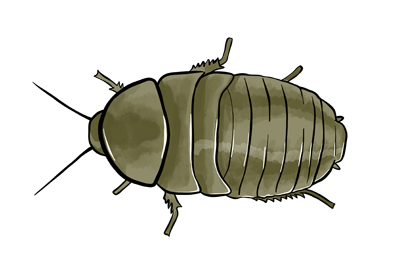Pacman Frog Care Sheet & Pet Guide
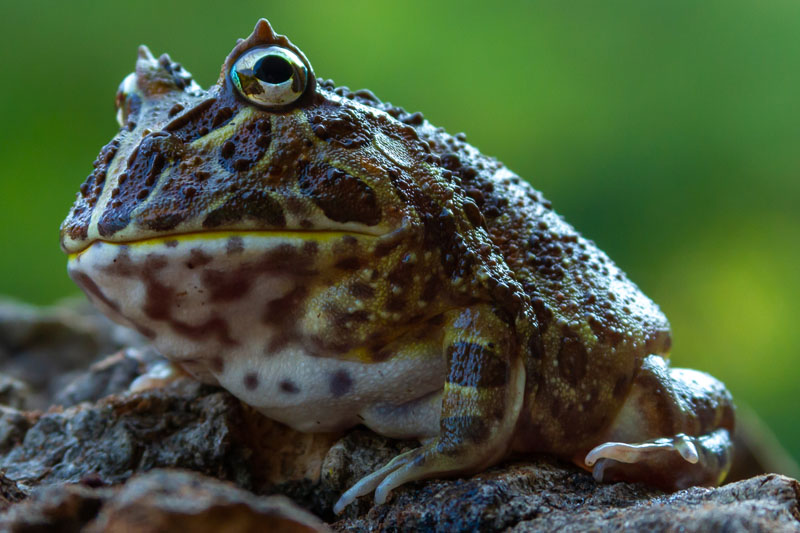
The common name “Pacman Frog” describes 8 species within the Ceratophrys genus. They’re also known as “South American Horned Frogs”. They are very popular pets and surprisingly, Pacman frogs are easy to care for!
Amphibians are delicate animals. Pacman frogs, of course, are amphibians, and their survival hinges upon proper husbandry! Temperature and humidity are especially important. Their captive habitat should replicate their natural environment as much as possible.
Don’t worry, it’s not too difficult and I’ll show you how to do it!
My boys’ third pet frog was a Pacman frog. We still have him! He spends the majority of his time burrowed into the substrate in his small terrarium. We love watching him eat.
Table of Contents
Pacman Frogs as Pets
The reason I told you about my sons’ Pacman frog in the opening paragraphs is that I want you to know I have personal experience keeping them! Not only that, I’ve conducted countless hours of research!
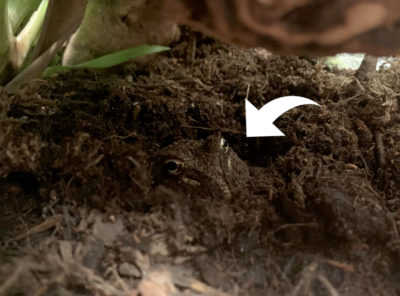
Pacman Frogs are great pets depending on your situation. I’ll explain. Amphibians don’t do well with handling. This is especially true with Pacman Frogs. They want to be left alone. Sticking your finger too close to one will likely result in you getting bit, too!
If you’re looking for something to play with, get a dog. If you’re looking for a small pet you can handle often, get a leopard gecko. Want a cool frog to look at in a tank? Get a Pacman Frog!
Housing Your Pacman Frog
If you’re going to keep a South American Horned Frog as a pet, and you don’t live in South America, you’re going to need an enclosure! No worries, setting up a Pacman Frog’s enclosure is simple. Because they spend most of their time burrowed into the substrate, they don’t require a lot of space.
Therefore, a small tank will suffice. You’ll want the temperature and humidity to match that of their natural habitat in the wild. Lighting is important, too. I’ll go over this and more in the sections below.
Before we look at the specific items you will need, let’s look at the climate requirements. Knowing these things will give you a better understanding of why you need certain products to make the perfect habitat!
The climate within your Pacman Frog’s Enclosure
Pacman Frogs are endemic to South America, from the Northern tips of Colombia and Venezuela all the way down to Argentina. They’re found under leaf litter on the floor of tropical and subtropical, broadleaf forests.
Two of the most popular species are C. cranwelli and C. ornata, both of which inhabit the central regions of South America. These are the climates we’re trying to replicate in our Pacman Frog’s home. Why? Well, because they’re adapted to this type of climate. Anything drastically different will be detrimental to their health.
Temperature
The average temperature of the Gran Chaco region, a large area where most wild C. Cranwelli are found, ranges from 60 °F – 85 °F [1]. Record lows get much cooler and record highs, much hotter. The temperatures listed are average.
- Day-time temperature high of 82 °F (27.7 °C)
- Night-time temperature low of 65 °F (18.3 °C)
I have kept my Pacman Frog between these temperatures the entire time we’ve had him, with few exceptions. He is, in my humble opinion, a very healthy and happy frog!
Humidity
As with the temperature, the relative humidity highs and lows vary greatly but the average is between 50 – 75% within the regions ceratophrys are endemic to.
In order to maintain this relative humidity level, you will need to mist the enclosure daily. Make use of a hygrometer to track the level within the enclosure.
Some keepers have their enclosures furnished with automated fogging systems or misting systems. Both work well when set up properly. Otherwise, invest a few dollars into a manual pump mister or a simple spray bottle!
Tank / Terrarium
Because Pacman Frogs spend most of their time in one spot, you don’t need a large enclosure! Here are two tanks I recommend.
- 18″ x 18″ x18″ Glass Terrarium
- 10 – 20 Gallon Tank
I kept my Pacman Frog in a 10-gallon tank (aquarium) and eventually moved him into a 25-gallon front-opening terrarium. Both sizes worked great. The 25-gallon terrarium gave us more room for a large water container and a few more plants. Having said that, “Chomper” remained burrowed in the substrate, usually next to a plant in both enclosures.
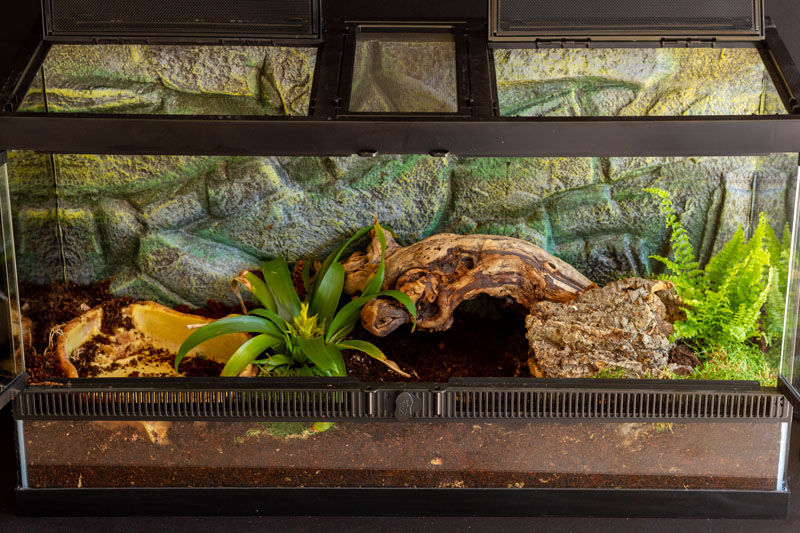
Substrate
The surface level on which an organism lives is the “substrate”. It’s the ground we walk on. For Pacman Frogs, the substrate is important. The reason substrate is important is because they spend a large amount of their life buried up to their eyes in it!
Pacman Frogs are ambush predators. They hide and wait for potential prey to walk by. The unsuspecting prey doesn’t stand a chance. Within an instant, the ferocious amphibian springs out of nowhere and swallows their prey whole. They’re hunting and this is why they burrow into the substrate.
So, what does all this mean for Pacman Frogs in captivity? Well, it means three things in particular.
- The substrate should be 3 – 4 inches deep
- It needs to be replaced over time*
- Substrate should be loose
Next, you need to replace the substrate roughly every 3 months. This depends on your setup, too. An established bioactive setup will have a healthy substrate that won’t need to be changed. Since bioactivity isn’t within the scope of this guide, I won’t get into it.
For most hobbyists, you’ll have to change out the substrate because it will eventually become too acidic for your delicate amphibian. A frog’s droppings are acidic and, over time, the substrate will become harmful. This is why it needs to be changed!
Finally, use a loose substrate. This will ensure your Pacman Frog can easily burrow into it. Zoo Med’s Eco Earth or Exo Terra’s Plantation Soil are great! Aside from this, you could opt for an ABG mix if you’re planning to create a bioactive setup or want to use live plants!
All of these substrates are loose and come highly recommended.
The boys and I made a bioactive setup! We use an ABG mix and have isopods and springtails. In addition to this, we have real plants!
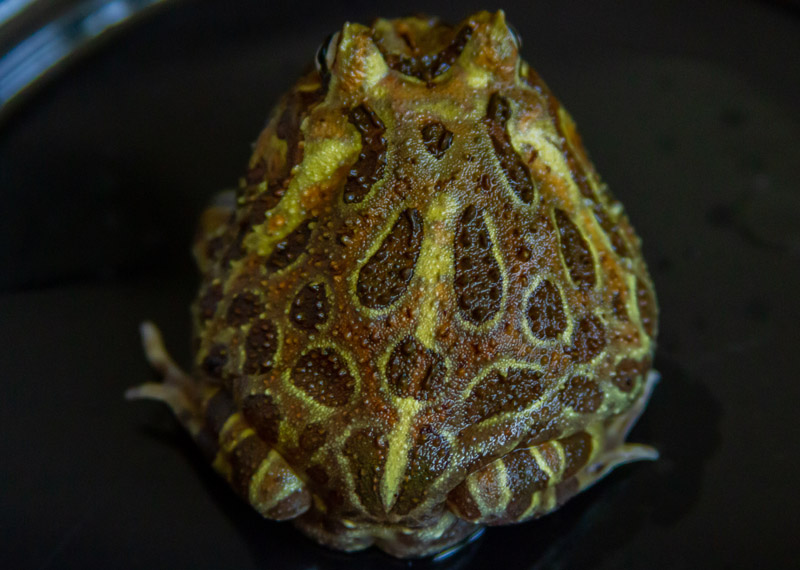
Plants & Decorations
You can use almost any plants or decorations you want to! Just be sure to think ahead – Don’t use something your pet can get hurt in/on. Plants and decorations with sharp edges should be avoided. Moreover, decorations that are too small could potentially be harmful if your Pacman Frog gets stuck!
Aside from that, real or fake plants are encouraged. As far as fake plants are concerned, feel free to use any of them. Real plants are different. They require careful planning.
Should you decide to use real plants there are two things to keep in mind. The first thing is to make sure to place your plants along the edges of the enclosure. Remember, Pacman Frogs love to burrow and their burrowing habits can affect the roots of your plants.
The second thing to remember about real, living plants is that they need nutrients, water, and light! An ABG mix for the substrate will benefit live plants tremendously. Due to the high humidity required by Pacman Frogs, your real plants should be getting enough water anyway. They will, however, need some type of grow light.
Also, it may go without saying but, get plants that are suited for a tropical or subtropical climate. For example, a cactus won’t survive due to the abundance of water.
Heating Elements
We learned early that the recommended temperature range for a Pacman Frog in captivity is between 65 °F – 82 °F (18.3 °C – 27.7 °C). This falls just shy of what most people consider “room temperature”.
- UTH (Under Tank Heater) is by far the preferred heating element for most Pacman Frog hobbyists. You need the correct size and wattage.
- Ceramic Heat Emitter is a less popular for this species. I’m not entirely sure why. A ceramic heat emitter on a thermostat works much better at heating the whole enclosure.
Whichever route you take, it’s important to get the setup correct! I recommend testing your setup before putting your frog into the enclosure. You can test by using a traditional thermometer or an infrared thermometer gun.
UTH (Under Tank Heater)
Under-tank heaters, also known as a “heat mat” or “heat pad”, can be dangerous for Pacman Frogs. The reason? Well, they burrow! Animals aren’t meant to have direct contact with them.
For this reason, it’s advisable to place the UTH on the side of the enclosure. Preferably on either end of the tank. This will help create a temperature gradient within the enclosure, allowing your pet the option of a warm side or cool side.
By the way, the size of the UTH required is generally based on the size of the enclosure. Use the chart below to see the recommended heat mat per tank size.
| Tank Size | Wattage | Brand |
|---|---|---|
| 10 – 20 Gallon | 8 | Zoo Med ReptiTherm |
| 10 – 20 Gallon | 8 | Zilla Heat Mat |
| 10 – 20 Gallon | 7 | Fluker’s Heat Mat |
These are great options for tanks between 10 – 20 gallons. It covers your basic 10 to 15-gallon tanks and also an 18″ x 18″ x 18″ Exo Terra terrarium. Anything larger, well, you’ll want to upgrade your heat mat!
Ceramic Heat Emitter / Heat Bulb
Using a ceramic heat emitter is not a bad option, especially for a frog that likes to burrow. Simply place the heat bulb directly above the tank (towards one side, if possible). In most cases, the heat bulb is placed inside a lamp fixture or “clamp lamp”.
These can be placed directly on top of a screen lid so long as the lid is made from a material that won’t catch on fire (most are). Otherwise, opt for a clamp lamp or find a mounting system to hang the heat bulb above the lid of the enclosure.
Because Pacman Frogs are terrestrial, they aren’t capable of climbing anywhere near the heating element. This is one of the benefits of a ceramic heat emitter or heat bulb.
Do remember, however, that you should always use a thermostat whether you’re going with a heat lamp or UTH.
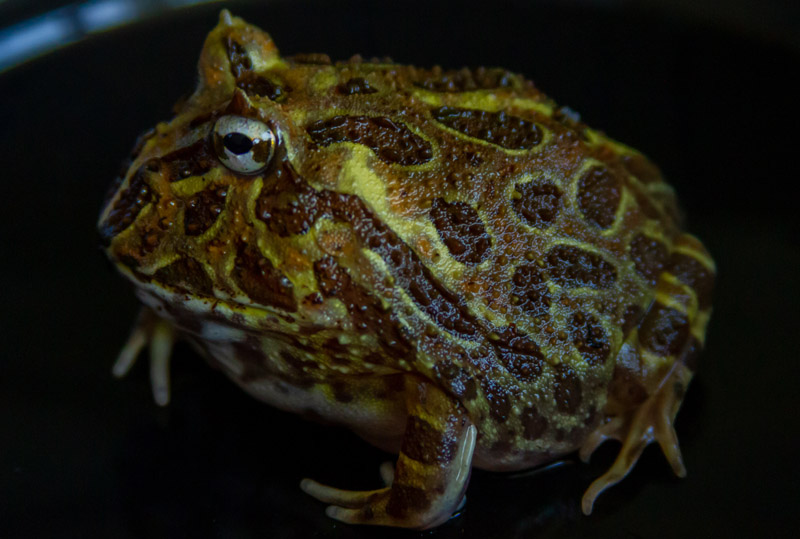
Thermostats & Rheostats
A thermostat regulates the temperature by turning the heating element on or off depending on the temperature. When the temperature exceeds a certain level, the heating element is shut off. Likewise, when the temperature drops below a certain level, the heating element turns on.
Rheostats are slightly different. They act like dimmers by controlling the electrical current going to the heating element. A rheostat is able to keep the temperature at the same level.
Both a thermostat and a rheostat are considered essential safety equipment. They protect your pets from overheating and can potentially protect you from a faulty heating element!
Lighting Setup
Because Pacman Frogs spend most of their time burrowed into the substrate on the floor of tropical forests, they don’t receive much UVB (even in the wild). They do receive some, of course, but not much. The general consensus in the hobby is that Pacman Frogs don’t need UVB.
Having said that, recent studies suggest nearly all reptiles and amphibians benefit from UVB. To read more about this, check out this post about Pacman Frog lighting requirements. It provides more details on the possible benefits of UVB and explains the reasoning behind it.
Whether you provide UVB or not, Pacman Frogs need a day and night cycle. Species within the Ceratophrys genus are found in regions with a mostly 12:12 photoperiod.
This means you should provide 12 hours of light and 12 hours of dark. In order to do this, you may need a lamp/light! The goal here is to create a day and night cycle.
Another thing to remember is if you’ve got real plants in your Pacman Frog’s enclosure, you’ll most likely need to use some type of grow light. This will ensure the plants are getting their lighting requirements too.
Pacman Frog Diet
Pacman Frogs are carnivores. They survive on live food. They eat nearly anything they can fit in their mouth! In the wild, they have access to a very, very large variety of insects. Things like crickets, spiders, moths, flies, and even small animals like mice, lizards, fish, and other amphibians. In captivity, however, options are limited.
Three important things to remember:
- Pacman Frogs eat mostly insects but are capable of eating small mice and feeder fish.
- Do not feed them anything you catch in the wild.
- They need supplements in order to remain healthy.
What to Feed Your Pacman Frog
Captive Pacman Frogs mostly eat what’s available at your local pet store or whatever you can cultivate on your own. For most hobbyists, the list of feeder insects looks like this:
- Crickets
- Mealworms
- Superworms
- Wax worms
- Dubia Roaches
- Feeder Fish
- Pinky Mice
The feeder insects you purchase at pet stores aren’t as healthy as they need to be in order to keep your Pacman Frog healthy. To make them more healthy, you need to do what is known as “gut loading”. Gut-loading feeder insects means you feed them a nutrient-rich diet at least 24 hours before feeding them to your frog. In the case of crickets – Feed them a slice of orange and some leftover vegetables.
When possible, do this at least 24 hours before feeding the crickets to your frog! This ensures the crickets are packed full of nutrients obtained from the fruits and vegetables. This, in turn, makes your Pacman Frog more healthy.
Gut-loading feeder insects won’t suffice in keeping your pet healthy. For this, you’ll need to make use of supplements.
Supplements
Dusting feeder insects with supplements is required in order to keep captive reptiles and amphibians healthy. The reason is that they don’t have access to the large variety of healthy food sources they would have in the wild.
One of the most important parts of keeping your Pacman Frog healthy is vitamin D3. Vitamin D3 helps process calcium which is needed for strong bones. Without it, they’re prone to developing MBD (Metabolic Bone Disease). It’s important to use a calcium supplement with vitamin D3. A multi-vitamin is good too.
My favorites:
- Rep-cal’s Calcium with Vitamin D3
- Rep-cal’s Herptivite (multi-vitamin)
There are plenty of other brands to choose from but most hobbyists agree that Rep-Cal and Repashy make the best products out there.
Supplementing amphibians can get tricky because a lot of them go without UVB bulbs. Pacman Frogs, for example, can go without a UVB bulb. UVB aids in the processing of vitamin D3. So, if a UVB bulb were set up properly, you wouldn’t need a vitamin D3 supplement. You would just use a calcium supplement instead. Otherwise, you might be giving too much D3 to your amphibian.
So, if you’re not using a UVB bulb, you should use calcium with D3 and I recommend dusting feeder insects with it for every feeding except once per week when you use a multi-vitamin!
I’ll explain more in the feeding schedule below.
Feeding Schedule
I’m going to recommend a feeding schedule in this section but I’m doing this with a caveat. Always pay attention to the size of your pets. If look overweight or underweight, something in their diet needs to change.
This means if you follow the feeding schedule on this website and find that your Pacman Frog is obese in a few months, you need to adjust accordingly by not feeding them as much! Likewise, if your frog looks underweight – feed him/her more.
Juvenile Pacman Frog:
Feed your juvenile 2 – 3 appropriately sized crickets 4 – 7 times per week. Use a calcium supplement twice per week and a vitamin supplement once per week.
Adult Pacman Frog:
| Monday | Wednesday | Friday |
|---|---|---|
| 3 Large Crickets | 2 Large Crickets | 1 Large Cricket |
| 2 Worms (wax worm, mealworm, etc) | 2 Dubia Roaches | |
| *Calcium w/D3 | *Calcium w/D3 | *Multi-vitamin |
- Appropriately sized – This means that the feeder insect, feeder fish, or pinky mice are no bigger than the distance between your frog’s eyes. This will allow your frog to eat without getting hurt.
- Variety – You don’t have to provide a variety of different food sources but it is recommended. I understand we’re all doing the best we can.
How to Feed A Pacman Frog
Feeding Pacman Frogs is the most exciting part of keeping them, in my opinion. Watching them eat is rather fascinating! It’s not challenging, as you’ll soon find out.
Take your feeder insects and place them in a cup or bag containing the vitamins and/or calcium supplements. Give it a gentle tossing in order to coat the insects in a thin layer of powder.
At this point, you can either gently scoop or tilt the container over so the insects drop into the terrarium or you can use feeding tongs. Feeding tongs will allow you to hold the feeder insect directly in front of your Pacman Frog without fear of getting bit.
Handling Your Pacman Frog
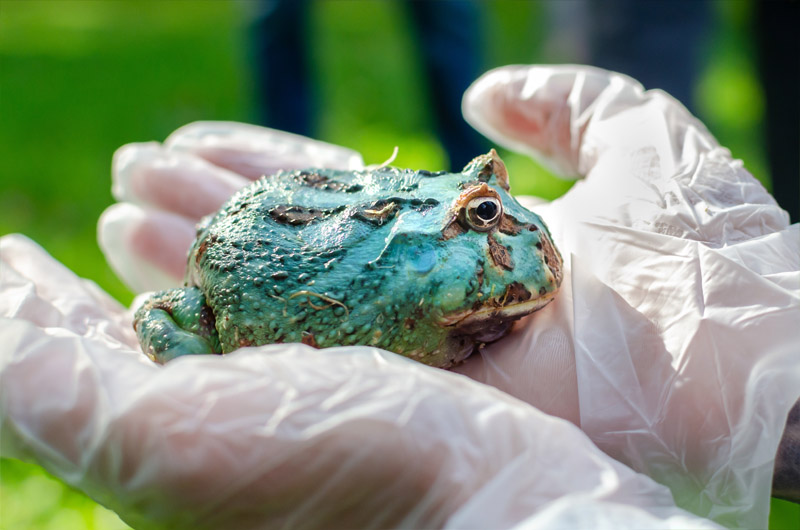
I strongly discourage handing Pacman Frogs. One reason is the fact that most amphibians don’t tolerate handling very well. The second reason is that Pacman Frogs are fairly aggressive. They do not want you touching them or holding them.
Handling causes unwanted stress for amphibians. Not only this but any toxins (from smoke, soap, etc) on your hands can be easily transferred into their semi-permeable skin [2].
While it’s tempting to hold your newly acquired Ceratophrys, be mindful of their vulnerabilities and opt for looking instead!
References
- Martin, Gene E. , Miller, Mark D.H. and Webb, Kempton E.. “Gran Chaco”. Encyclopedia Britannica, 20 Feb. 2015, https://www.britannica.com/place/Gran-Chaco. Accessed 16 August 2021.[↩]
- Llewelyn, V. K., Berger, L., & Glass, B. D. (2019). Permeability of frog skin to chemicals: effect of penetration enhancers. Heliyon, 5(8), e02127. https://doi.org/10.1016/j.heliyon.2019.e02127[↩]


